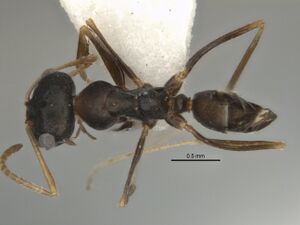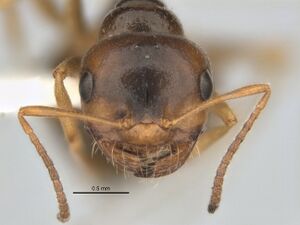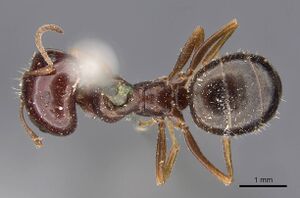Melophorus fieldi
| Melophorus fieldi | |
|---|---|

| |
| Scientific classification | |
| Kingdom: | Animalia |
| Phylum: | Arthropoda |
| Class: | Insecta |
| Order: | Hymenoptera |
| Family: | Formicidae |
| Subfamily: | Formicinae |
| Tribe: | Melophorini |
| Genus: | Melophorus |
| Species group: | biroi |
| Species complex: | fieldi |
| Species: | M. fieldi |
| Binomial name | |
| Melophorus fieldi Forel, 1910 | |
Three workers were collected in mallee scrub at Blyth, near Adelaide, South Australia and a worker taken at Broken Hill was collected near a creek. In WA, specimens from the north-eastern wheatbelt have been collected in red loamy soil in mallee and in dry sclerophyll woodland. In all likelihood this species, like Melophorus bruneus, is a generalist scavenger of animal and plant materials in semi-arid woodlands throughout its range. (Heterick et al. 2017)
Identification
Heterick et al. (2017) - Melophorus fieldi can be placed in the Melophoprus biroi species-group on the basis of characters of the clypeus, propodeum, mandible and palps. The species is also placed in the Melophoprus fieldi species-complex because of the appearance of the anteriorly placed clypeal psammophore, the compact propodeum, the presence of more than one preapical spine on the metatibia, at least in the major worker, the long, even spindly legs and the unmodified mandible in the major worker. Melophorus fieldi workers require careful checking to distinguish them from related species, particularly those of Melophorus turneri and Melophorus bruneus. Most M. fieldi workers can be distinguished from all taxa except M. bruneus by the following combination of characters: (1) eye relatively large (eye length 0.50× length of side of head capsule in minor worker, approximately 0.33× length of side of head capsule in major worker ≥), (2) in full-face view, periphery of upper frons surrounded to about the level of the eyes with short, bristly, erect setae that are often flattened distally; (3) minor worker small (HW ≈ 0.56-0.59 mm); (4) non-iridescent head of major worker relatively smooth and gleaming and, (5) clypeal psammophore of fine setae placed at or about midpoint of clypeus. The minor worker of M. fieldi is a concolorous blackish-brown, finely shagreenate with a dull silky sheen, while, in profile, the pronotum rises gradually to its junction with the mesonotum without any obvious convexity and the mesonotum is slightly humped (see the M. bruneus identification section for differences between M. fieldi and that species in these particulars). The mesosoma has a few to many short, straight, bristly setae, these often expanded distally, the length of the longest setae ≤ greatest length of antennal scape, and the appressed setae are short and inconspicuous. The major and media worker and media workers are concolorous brown (the holotype is an orange-yellow with a brown gaster), with scattered short, sometimes modified setae and the appressed setae on the gaster are well-separated and do not overlap (unlike the case with M. bruneus).
What we here determine to be major workers of Melophorus fieldi are difficult to distinguish from the major workers of Melophorus bruneus, with which they share the same features (e.g., large eyes, short antennal scapes and circlet of short, stout setae on the vertex). The degree of pilosity, however, differs for the two taxa, with M. bruneus being more hirsute. The minor workers have a characteristic facies, with very large, bulging eyes, black, matt, highly microreticulate mesosoma with a silky sheen and a few scattered short, erect setae on the dorsum of the mesosoma.
Distribution
Heterick et al. (2017) - Specimens have been collected from NSW, NT, SA and WA.
Distribution based on Regional Taxon Lists
Australasian Region: Australia (type locality).
Distribution based on AntMaps
Distribution based on AntWeb specimens
Check data from AntWeb
Countries Occupied
| Number of countries occupied by this species based on AntWiki Regional Taxon Lists. In general, fewer countries occupied indicates a narrower range, while more countries indicates a more widespread species. |

|
Estimated Abundance
| Relative abundance based on number of AntMaps records per species (this species within the purple bar). Fewer records (to the left) indicates a less abundant/encountered species while more records (to the right) indicates more abundant/encountered species. |

|
Biology
Castes
Worker
   
| |
| Worker (minor). . | Owned by Australian National Insect Collection. |
   
| |
| Worker (major). . | |
   
| |
| Synytype of Melophorus fieldi. . | Owned by Australian National Insect Collection. |
Images from AntWeb
   
| |
| Syntype of Melophorus fieldi major. Worker (major/soldier). Specimen code casent0909812. Photographer Z. Lieberman, uploaded by California Academy of Sciences. | Owned by MHNG, Geneva, Switzerland. |
   
| |
| Syntype of Melophorus fieldi major. Worker. Specimen code casent0909813. Photographer Z. Lieberman, uploaded by California Academy of Sciences. | Owned by MHNG, Geneva, Switzerland. |
Phylogeny
| Melophorus |
| ||||||||||||||||||||||||||||||||||||
Based on Heterick et al., 2017. Only selected species groups/complexes are included.
Nomenclature
The following information is derived from Barry Bolton's Online Catalogue of the Ants of the World.
- fieldi. Melophorus fieldi Forel, 1910b: 62 (s.) AUSTRALIA. Combination in M. (Erimelophorus): Wheeler, W.M. 1935c: 71.
Unless otherwise noted the text for the remainder of this section is reported from the publication that includes the original description.
Heterick et al. (2017) - Mention must be made here of the strikingly different colour of the holotype, which is only slightly paler than syntypes of M. turneri aesopus, collected from the same area at the same time as M. fieldi by Field. The holotype, a major worker, is bright orange-yellow with a brown gaster, compared with the uniformly chocolate colouration of normal M. fieldi major workers. Possibly, genuine M. fieldi represents a third species, unrepresented among material we have seen and are ascribing to that taxon; but against this is the fact that all other features of the non-types appear to conform to the description of the species (the ant is not identical with the often lighter-coloured M. bruneus because the erect setae are sparse on the mesosoma and the appressed setae on the gaster do not overlap). Other Melophorus species can also be very colour-variable. Forel mentions that the gaster on this specimen was distended, but no mention is made in the description of whether the ant was collected while foraging or from the nest. If collected from the nest, one would expect other workers to have also been collected. However, if collected from near a nest this ant may be a teneral (although the specimen looks sturdy enough). Having said all this, additional material of the light-coloured morph from the type locality, especially if minor workers are also collected, may require the taxonomy of M. fieldi to be revisited.
As with Melophorus bruneus, sequencing, even of fresh nest material, has produced poor results for this species. The ant clusters with Melophorus parvimolaris on a three-gene tree, but this placement is undoubtedly factitious.
Description
Worker
Heterick et al. (2017) - (n = 6): CI 105–115; EI 26–42; EL 0.24–0.31; HL 0.54–1.03; HW 0.56–1.19; ML 0.79–1.32; MTL 0.56–0.84; PpH 0.09–0.13; PpL 0.33–0.56; SI 77–127; SL 0.71–0.92.
Minor. Head. Head square; posterior margin of head weakly convex; frons matt or with weak sheen, shagreenate; pilosity of frons a mixture of a few well-spaced, erect setae interspersed with appressed setae only. Eye large (eye length ≥0.50 × length of side of head capsule); in full-face view, eyes set at about midpoint of head capsule; in profile, eye set around midline of head capsule; roughly ovoid, eye narrowed posteriad. In full-face view, frontal carinae straight, divergent posteriad; frontal lobes curved toward antennal insertion. Anteromedial clypeal margin broadly and evenly convex; clypeal psammophore set at or above midpoint of clypeus; palp formula 6,4. Mandibular teeth in minor worker four to five; mandibles narrow, strap-like, internal and external margins parallel or nearly so; third mandibular tooth distinctly shorter than apical tooth and teeth numbers two and four; masticatory margin of mandibles approximately vertical or weakly oblique. Mesosoma. Integument of pronotum, mesonotum and mesopleuron moderately shining and shagreenate throughout; anterior mesosoma in profile broadly convex; appearance of erect pronotal setae short, (i.e., longest erect setae shorter than length of eye) and unmodified; in profile, metanotal groove shallow, indicated mainly by an angle; propodeum shining and shagreenate; propodeum angulate, propodeal angle blunt; length ratio of propodeal dorsum to its declivity about1:1; erect propodeal setae present and sparse to moderate (1-12); appressed propodeal setulae short, separated by more than own length and inconspicuous; propodeal spiracle situated at least twice its width from the declivitous face of propodeum, and shorter (length < 0.50 × height of propodeum). Petiole. In profile, petiolar node squamiform; in full-face view, shape of petiolar node tapered with blunt vertex; node shining and distinctly shagreenate-microreticulate. Gaster. Gaster weakly shining with indistinct shagreenation, or shining, shagreenate (‘LP record’ appearance); pilosity of first gastral tergite consisting of well-spaced, erect and semi-erect setae interspersed with regularly placed appressed setae. General characters. Colour dark chocolate.
Major. Head. Head horizontally rectangular, broader than wide; posterior margin of head planar or weakly convex; cuticle of frons shining with superficial shagreenation or microreticulation only; pilosity of frons a mixture of a few well-spaced, erect setae interspersed with appressed setae only. Eye moderate (eye length 0.20–0.49 length of head capsule); in full-face view, eyes set at about midpoint of head capsule; in profile, eye set anteriad of midline of head capsule; roughly ovoid, eye narrowed posteriad. In full-face view, frontal carinae straight or weakly convex; frontal lobes curved inward in front of antennal insertion. Anterior clypeal margin broadly and evenly convex; clypeal psammophore set at or above midpoint of clypeus; palp formula 6,4. Five mandibular teeth in major worker; mandibles narrow, strap-like, internal and external borders parallel or nearly so; third mandibular tooth distinctly shorter than apical tooth and teeth numbers two and four; masticatory margin of mandibles approximately aligned vertically or weakly oblique. Mesosoma. Integument of pronotum, mesonotum and mesopleuron matt or with weak sheen and microreticulate throughout; anterior mesosoma in profile broadly convex; erect pronotal setae short, (i.e., shorter than length of eye) and unmodified; in profile, metanotal groove shallow, broadly V- or U-shaped; propodeum shining and shagreenate; propodeum smoothly rounded or with indistinct angle; propodeal dorsum and declivity confluent; erect propodeal setae present and abundant (at least a dozen); appressed propodeal setae short, separated by more than own length and inconspicuous; propodeal spiracle situated nearer to midpoint of propodeum than to its declivitous face, and shorter (length less than 0.50 × height of propodeum). Petiole. In profile, petiolar node squamiform; in full-face view, shape of petiolar node tapered with blunt vertex; node shining and faintly shagreenate-microreticulate. Gaster. Gaster shining, shagreenate (‘LP record’ appearance); pilosity of first gastral tergite consisting of well-spaced, short, thick, erect setae interspersed with minute, appressed setae. General characters. Colour brown, lower frons and appendages generally pale brownish-yellow (however, the holotype has bright orange-yellow fore-parts and brown gaster).
Type Material
Heterick et al. (2017) - Type. Holotype major worker, Tennants [sic] Creek, Northern Territory Musee d'Histoire Naturelle Genève examined.
Type Material
- Holotype, worker, Tennant Creek, Northern Territory, Australia, Musee d'Histoire Naturelle Genève.
References
- Forel, A. 1910b. Formicides australiens reçus de MM. Froggatt et Rowland Turner. Rev. Suisse Zool. 18: 1-94 (page 62, soldier described)
- Heterick, B.E. 2021. A guide to the ants of Western Australia. Part I: Systematics. Records of the Western Australian Museum, Supplement 86, 1-245 (doi:10.18195/issn.0313-122x.86.2021.001-245).
- Heterick, B.E. 2022. A guide to the ants of Western Australia. Part II: Distribution and biology. Records of the Western Australian Museum, supplement 86: 247-510 (doi:10.18195/issn.0313-122x.86.2022.247-510).
- Heterick, B.E., Castalanelli, M., Shattuck, S.O. 2017. Revision of the ant genus Melophorus (Hymenoptera, Formicidae). ZooKeys 700, 1–420 (doi: 10.3897/zookeys.700.11784).
- Wheeler, W. M. 1935c. Myrmecological notes. Psyche (Camb.) 42: 68-72 (page 71, Combination in M. (Erimelophorus))

